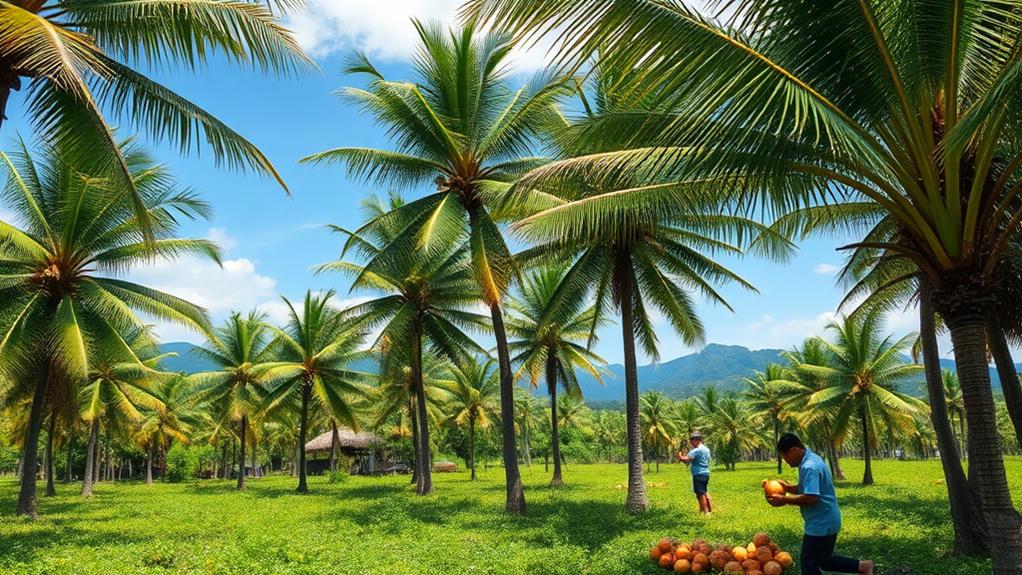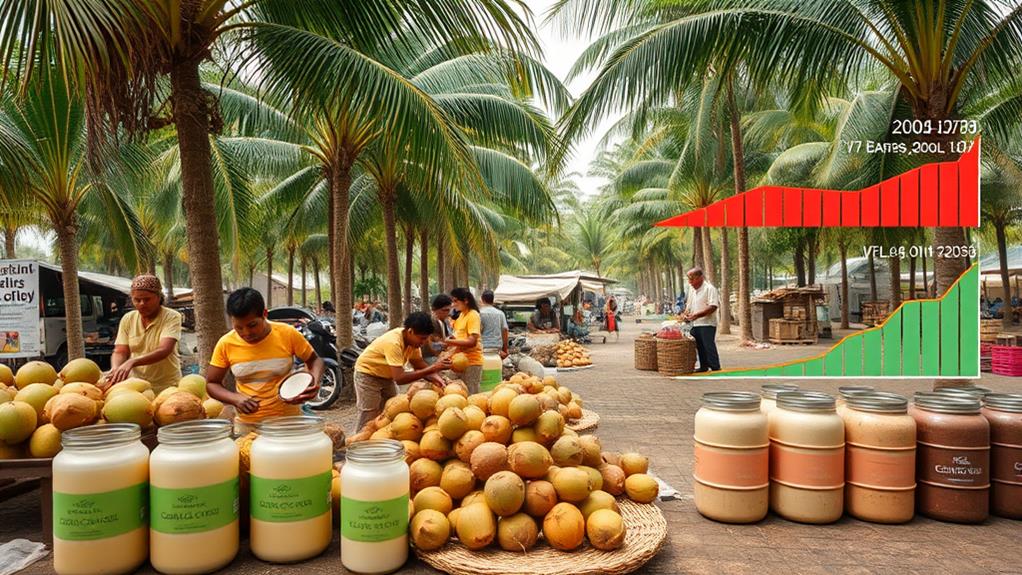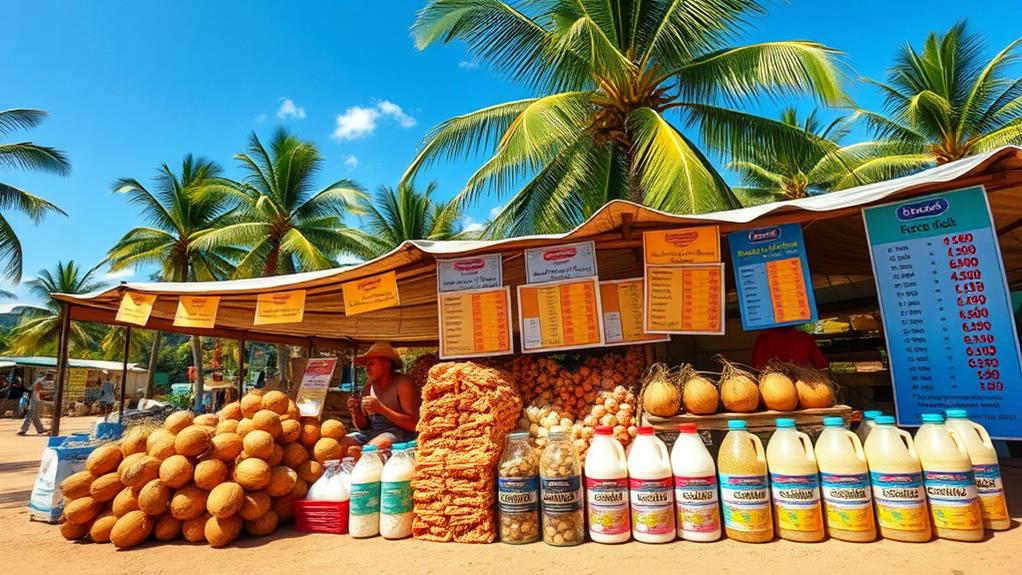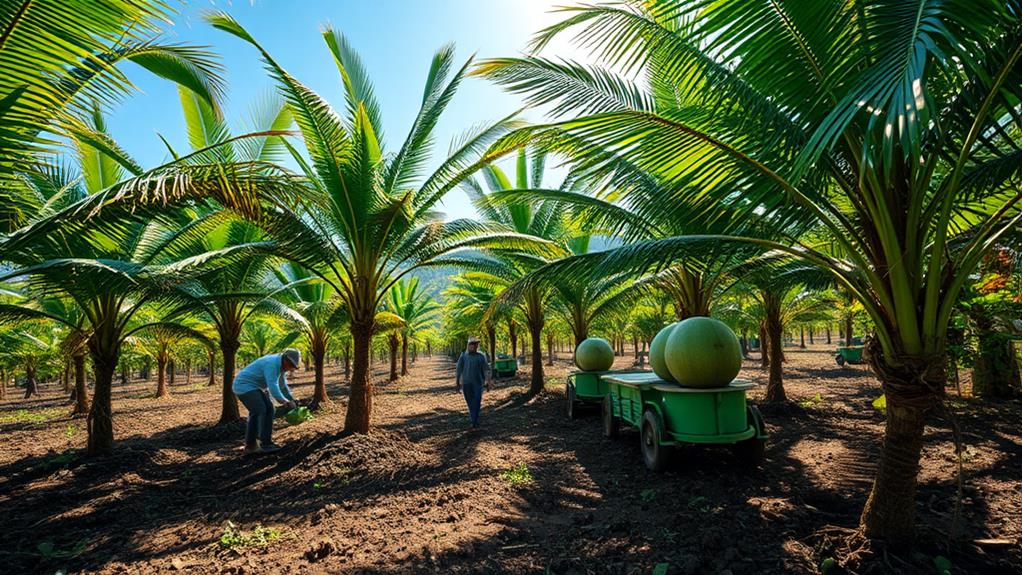The Philippine coconut industry is very important in the global market. It has shifted from producing copra to making coconut oil.
In 2021, the Philippines was the largest exporter of coconut oil, sending out 907,606 metric tons (MT) and earning about $1.44 billion. The main buyers of this oil are the USA and the Netherlands. This shows that there is a need for better policies to help the industry compete.
The Davao Region is crucial for local economies as it contributes a lot to coconut production.
Using sustainable farming practices is important for the industry's future growth. By understanding these facts, we can see the potential of the coconut industry especially with the increasing global demand for coconut products.
Overview of Philippine Coconut Production

The Philippine coconut industry is important for the country's economy. It's the second-largest producer of coconut products in the world, following Indonesia. The Philippine Coconut Authority oversees this sector, which is becoming increasingly important due to the growing global demand for coconut oil and other products.
In 2018, the Davao Region contributed 14.4% of the total coconut production in the Philippines. This shows how vital the region is to the industry. Products like copra (dried coconut meat) and coconut oil are key players in both local markets and international trade.
The Philippines is known for its expertise in coconut oil extraction, making it a preferred supplier for various industries, which helps boost exports.
Additionally, the coconut sector provides jobs for many smallholder farmers and their communities. As demand for coconut products increases, it's essential for the Philippine government and industry stakeholders to focus on sustainable practices and innovation.
This approach will help improve productivity and ensure that the coconut industry remains a vital part of the country's economic growth.
Non-Traditional Coconut Products
Non-traditional coconut products are becoming more popular in the Philippines. These products go beyond traditional items like copra and coconut oil. The rise in demand for these products shows their ability to diversify the coconut industry and support the economy.
Here are four important non-traditional coconut products:
- Coconut Water: This drink is now a popular choice for hydration, leading to increased exports.
- Coconut Milk Powder: This ingredient is used in cooking and baking, appealing to health-conscious consumers and creating more market opportunities.
- Coco Chemicals: These are made from leftover materials from coconut processing and promote sustainable practices in various industries.
- Handicrafts from Coco Shells: These products support local artisans and cater to the eco-friendly market.
In 2018, the Davao Region produced 14.4% of the national coconut supply, highlighting its importance in providing both traditional and non-traditional coconut products.
As the second-largest global producer of coconuts, the Philippines must focus on these new products to meet increasing international demand and ensure growth in the industry.
Coconut Oil Trade Statistics

The coconut oil trade in the Philippines shows important trends affecting the economy.
In 2021, the Philippines exported 594,924 metric tons (MT) of coconut oil. This was a drop from 721,570 MT in 2020. The decrease raises concerns about the future of coconut oil exports.
In 2022, the Philippines was the top global exporter of crude copra oil, with exports valued at $1.44 billion.
The main markets for Philippine coconut oil in 2022 were the Netherlands, USA, and Germany. These countries accounted for $582 million, $232 million, and $159 million of total exports, respectively.
Coconut oil prices also changed significantly. They fell from $1,961 per MT in November 2021 to $1,696 per MT in December 2021.
Additionally, U.S. imports of lauric oils reached 1.23 million tons in early 2021, showing a growing global demand for coconut oil products.
These statistics highlight the need for strong policies to help stabilize production and improve the Philippines' position in the coconut oil market.
Economic Impact of Coconut Exports
In 2022, the coconut export sector in the Philippines generated $1.44 billion from crude copra oil alone. This revenue shows the importance of coconut products, which contributed around $2.68 billion to the country's total export earnings. This amount represents about 3.59% of the nation's exports.
The economic impact is significant as it affects the lives of coconut farmers and local economies, especially in the Davao Region, which produces 14.4% of the total coconut production.
The Philippines is the largest exporter of coconut oil in the world, exporting 907,606 metric tons (MT) in 2021. New markets in the Netherlands and Germany reveal a growing demand for coconut products.
Coconut exports provide stable incomes for thousands of coconut farmers. The increase in coconut oil exports suggests there's potential for more investment and growth in the agricultural sector.
As government officials work to improve the coconut industry, it's essential to understand the economic impacts to ensure sustainable growth and support for coconut farmers.
Import Analysis in Key Markets

The import market for Philippine coconut products is growing, especially in Canada. In 2018, Canada imported $148.9 million worth of agri-food and seafood from the Philippines. The top products included coconut oil, desiccated coconuts, and bakery items. Major supermarkets in British Columbia stock these products, and Filipino stores in Metro Vancouver help make them more available to consumers.
Importers like Corinthian Distributors, AFOD Ltd., and Uno Foods are important for bringing Philippine coconut products into Canada. Their work supports the rising popularity of coconut oil, which fits with consumer trends that focus on natural and healthy options. From 2021 to 2022, Canada became one of the fastest-growing markets for these products, with a $77.3k increase in imports.
On a global level, the Philippines was the 88th largest importer in 2022, with a total import value of $159,000. The country mainly imported crude coconut oil from key markets like Canada, the UK, Japan, Singapore, and the USA.
This information highlights the need to strengthen trade relationships to support the Philippine coconut industry.
Latest Trends in Coconut Industry
The Philippine coconut industry is growing rapidly due to strong export sales and rising global demand. In 2022, the Philippines exported $1.44 billion worth of coconut oil, making it the top exporter in the world. In June 2024, coconut product exports reached $66.3 million, showing a 55.4% increase compared to the previous year. The main markets for these exports are the Netherlands and the USA.
Key trends in the industry include:
- US imports of coconut oil rose to 771,459 metric tons in 2021, a 62.4% increase from 2020.
- The average price of coconut copra was at its highest in 2022, driven by increased global demand.
- The Netherlands and Germany are the fastest-growing markets for Philippine coconut products from 2021 to 2022.
- The rising popularity of coconut oil in health and beauty products is boosting demand.
These trends show a bright future for the Philippine coconut industry.
It's essential to create policies that promote sustainable production and export strategies to meet the growing global demand.
Domestic Wholesale Price Trends

Coconut copra prices in the Philippines have changed a lot over the last ten years.
From 2013 to 2023, the lowest prices occurred in 2013, while the highest prices were recorded in 2022. This shows how the balance between supply and demand affects prices. Such fluctuations can impact the income of local farmers and businesses.
The Philippine Statistics Authority (PSA) reports that average wholesale prices have generally increased during some years, but 2023 has shown more stable prices. This stability is important for those in coconut oil production because it allows for better financial planning.
Historical price data helps us understand market trends.
By looking at these trends, businesses can make better decisions and adapt to changes in the coconut copra market.
How Does Geography Affect the Philippine Coconut Industry and Global Demand for Coconut Oil?
The impact of filipino geography on the coconut industry is significant. The country’s abundance of coconut-friendly lands and climate allows for high production. This, in turn, affects the global demand for coconut oil, as the Philippines is one of the largest exporters. Geography plays a crucial role in shaping this lucrative industry.
Market Competitiveness and Outlook
Fluctuations in wholesale coconut prices affect the competitiveness of the Philippine coconut industry in the global market. In 2022, the Philippines was the largest exporter of coconut oil, with an export value of $1.44 billion.
To maintain this leadership, several key areas need improvement:
- Production Efficiency: Enhancing the production processes can lead to better quality coconut oil and lower costs.
- Market Diversification: Seeking new markets can reduce dependence on traditional buyers like the USA and the Netherlands.
- Investment in Technology: Using advanced technology can improve operations, making the industry more competitive against countries like Indonesia and Papua New Guinea.
- Policy Support: Government programs that assist farmers and exporters can further boost the coconut industry.
The growth in export markets, especially in the Netherlands and Germany, shows a rising demand for coconut oil. As of June 2024, coconut product exports increased by 55.4% year-on-year.
Sustainable Practices in Coconut Farming

Sustainable practices in coconut farming help smallholder farmers improve their productivity and adapt to challenges. Farmers growing less than four hectares often deal with low prices and market changes. The Farmer Business School (FBS) approach teaches these farmers important skills for better farm management. The goal is to reach 10,000 farmers in regions like Southern Mindanao and Palawan.
Training programs focus on specific needs of farmers, like intercropping. This means planting different crops alongside coconuts, which helps farmers not rely only on coconut sales. Diversification makes their farming more sustainable.
Working with organizations like GIZ and Cargill builds farmers' skills and connections, leading to better productivity. A new training manual on sustainable practices is being created. It will use LandScale to assess how these methods impact local communities and ecosystems.
This ensures that coconut products are made in an environmentally friendly way. By adopting these practices, farmers in the Philippines can have a stronger coconut industry and better livelihoods.
Questions and Answers
What Is the Status of the Coconut Industry in the Philippines?
The status of the coconut industry in the Philippines shows a focus on sustainability practices. This means that efforts are being made to ensure that coconut farming does not harm the environment. For example, farmers are using organic methods to grow coconuts, which helps preserve soil health.
There is also an emphasis on value addition through processing innovations. This means that instead of just selling raw coconuts, products like coconut oil, coconut milk, and desiccated coconut are being made. This adds more value and helps farmers earn more money.
Efforts are in place to enhance productivity and stabilize prices. This is important because it supports smallholder farmers, who are often the backbone of the industry. For instance, training programs are being offered to teach farmers better farming techniques.
What Rank Is the Philippines in Coconut Production?
The Philippines ranks second in coconut production worldwide. This means that after Indonesia, the Philippines produces the most coconuts. The country faces some challenges in production, but it grows many different types of coconuts. These varieties provide good chances for export, which helps improve the economy and strengthen its place in the global market.
Is the Philippines the Largest Exporter of Coconuts?
Yes, the Philippines is the largest exporter of coconuts. This means that the country sells more coconuts to other nations than any other country. Coconuts are important products for the Philippines, as they are used to make food items, oil, and other goods. However, there are challenges that may affect future exports. These include issues like sustainability, which means growing coconuts in a way that does not harm the environment. Additionally, there is market competition from other coconut-producing countries. Overall, while the Philippines leads in coconut exports now, these factors could influence its position in the future.
What Is the Coconut Trade in the Philippines?
The coconut trade in the Philippines has some export challenges that affect how much is sold to other countries. For example, fluctuating global demand means that sometimes buyers want more coconuts, and other times they want less. This can be hard for farmers who rely on steady sales.
Despite these challenges, the trade also focuses on coconut sustainability. This means finding ways to grow coconuts that do not harm the environment. One way this is done is through value addition, which includes making products like coconut oil. By creating these products, farmers can earn more money and help boost the economy.